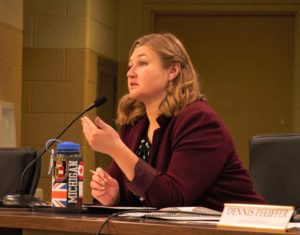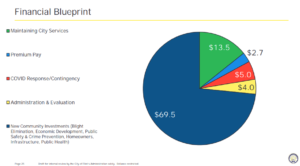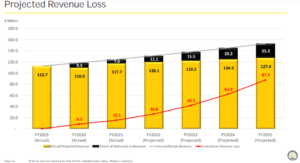By Tom Travis
Mayor Sheldon Neeley and his administration outlined a proposal to allocate the $94 million American Rescue Plan funds awarded to Flint in April 2021 at a special city council meeting Monday.
The proposal calls for $69.5 million of the funds to be used for housing and blight elimination ($33.6 million); economic development ($11.57 million); safety and crime prevention ($10.2 million); infrastructure ($7.475 million) and public health ($6.6 million). The administration is calling that bundle of proposals “New Community Investments.”
Four other categories and amounts, totaling $25 million, include:
- $13.5 million for Maintaining City Services
- $5 million for COVID Response and Contingency
- $4 million for Administration and Evaluation (part of these funds will be used to pay for the Ernst & Young contract)
- $2.7 million for Premium Pay for essential workers.
“We look at these dollars as transformation — making sure we can get to other side of this pandemic,” Mayor Neeley told the council.
The council responded with a set of stinging critiques, led by Councilperson Dennis Pfeiffer, who said, “Where are the details? I want details,” and asserting the outline provided was too general. He added, “If you want us to allocate funds for these buckets, I’m a hard no.”
Power Point presentation of Mayor Neeley’s plan to allocate ARPA funds. YouTube link of recording of the Special City Council meeting and Mayor’s presentation.Widigan explains “projected revenue loss”
The city’s Chief Financial Officer (CFO) Robert Widigan, explained to the council an “important component” of the ARPA funds allocation which breaks down “a calculation of the projected revenue loss.” The calculation is based off of the U.S. Treasury guidelines, according to Widigan.
He also reminded the council that after the one-time ARPA funds are spent, the city still is likely to be in financial peril.
The U.S. Treasury guidelines assume communities will see an estimated 5.1 percent growth. The City’s finance department shows its estimated revenue growth for the city depicted in the graphic below by a “yellow bar.”
Projected Revenue Loss from the Mayor’s ARPA fund allocation presentation. (Graphic source: Mayor’s ARPA presentation)
The gap between what the U.S Treasury assumes as growth compared to the City of Flint’s finance department’s assumed growth is depicted by a “solid black bar” in the graphic, above the yellow bar. The red line cutting through the graphic symbolizes the overall revenue loss, Widigan explained.
He added, “Each year these figures will have to be recalculated.”
Flint residents participated in “listening sessions”
The Mayor’s administration had held a series of four “listening sessions” over the past few months for the community to share their thoughts about how they believe the ARPA funds should be spent. The Flint residents’ priorities from those listening sessions, with paraphrases of what they said, are listed here:
Blight & Housing
Improve neighborhood landscaping
Renters are not getting sufficient support from their landlords when it comes to maintaining their homes
Residents cannot afford the cost of necessary home repairs
Economic Development
Improve residents’ access to childcare
Aid at-risk youth and address issues that may have been exacerbated from the pandemic
Public Safety
Hire additional police officers
Increase policing and penalties on squatters and thieves who inhabit and steal from blighted structures
Increased presence of security cameras
Add speedbumps on highly trafficked streets
Infrastructure
Sidewalk repair and ADA compliant crossings
Updated playgrounds
Water and sewer infrastructure upgrades
Public Health
Access to mental healthcare
Expanded accessibility for individuals with disabilities
Urban farming projects to increase public health and access to healthy food
Timeline and review of federal ARPA dollars
In April 2021 the federal government announced plans to award ARP (pandemic stimulus money) to municipalities around the country to help communities rebound from the economic impact of the COVID impact. $94 million was awarded to the city of Flint.
In contrast, Detroit was awarded $826 million, Saginaw – $52 million, Lansing – $50 million, Benton Harbor – $4.9 million and Clarkston was awarded $150,000.
Role of the compliance firm Ernst & Young
In January 2022 the city council approved a $1.1 million contract with compliance consultant Ernst & Young of Detroit for compliance and implementation of the American Rescue Plan (ARP) stimulus money.
According to an email to East Village Magazine (EVM) from the city’s Chief Financial Officer (CFO) Robert Widigan, “Ernst & Young provided guidance and support on the process that the City Administration undertook to develop the priorities and identify the projects that were proposed in the draft ARPA plan.
“The City Administration considered the inputs from citizens as part of that process and identified the priorities and suggested funding opportunities as a result of a significant effort from workgroups organized internally. Ernst & Young advised the City Administration on the process and the eligibility of proposed programs consistent with their role as a compliance resource.
“Ernst & Young will continue to provide support related to compliance, reporting, and communication to stakeholders (City Administration, City Council, Citizens) as part of their role in the ARPA efforts.”

City Council chambers Monday on the third floor of City Hall. (Photo by Tom Travis)
Council delivers a stinging response to Mayor and his administration
After the Mayor’s nearly 20-minute ARPA presentation, the council responded.
Councilmember Dennis Pfeiffer (Ward 8) was the first to fire off a series of sharp and stinging responses.
Pfeiffer asked, “Where are the details? I want details. You want us to give you $2.8 million for neighborhood clean up, what does that mean? This is a great outline but if you want us to allocate funds for these buckets I’m a hard no.”
“I think the residents want details. What’s actually going to happen? And not just generalized bullet points.”
“Are any of these dollars going to be leveraged? I know Ernst & Young promised leveraged dollars and so far there have been zero.”
Councilmember and Finance Committee Chairperson Tonya Burns (Ward 6) launched a more than 10-minute grilling of Mayor Neeley and his administration.
“I agree with my colleague in the Eighth Ward,” she said. “Pictures are nice, it’s a cute pie chart. But I can’t imagine a more disappointing way to present this to us. Where are the details?”

Councilperson and Finance Committee Chair Tonya Burns (Ward 6). (Photo by Tom Travis)
“This was supposed to create some serious relief for our community,” Burns said. “Nice Power Point — I loved the graphics.
“We wanted some real relief. You cannot skip over the people and think it’s okay,” she added. Burns accused the Mayor and his administration that they are not being transparent and “don’t care.” Burns criticized the Mayor and administration for “not showing up” when the council adopted the city’s $64 million budget.
Councilmember Eric Mays (Ward 1) implored the citizens of Flint to “pay attention” over the next few days and weeks as the council works with the Mayor’s plan to spend the federal ARP funds.

Eric Mays, with a young Flint resident seated beside him, addresses the Mayor and his administration in Monday’s meeting. (Photo by Tom Travis)
Mays explained two priorities for him in the allocation of ARPA funds are public safety and blight. “They come first. They go parallel,” he said. “They are number one and number two. Tore up houses and high grass in a community begets crime. People want a clean city — a protected city,” Mays said.
Councilperson Judy Priestley (Ward 4) began, “I am very disappointed that I had to have a member of the media show me a picture of one of the pages from the ARPA presentation. I didn’t have that opportunity. I think it’s a shame the press had the presentation before the council did.”

Councilperson Judy Priestley (Ward 4). (Photo by Tom Travis)
Councilperson Ladel Lewis (Ward 2) asked the administration if their presentation is “data driven” based off of the surveys and community listening sessions.

Councilperson Ladel Lewis (Ward 2). (Photo by Tom Travis)
The City Council also had held their own series of community listening sessions in each of the city’s nine wards over the past few months. Lewis asked CFO Widigan if the city administration was “able to implement the data from the council listening sessions as well.”
Widigan said, “We did take a look at them to get the data and we have them and they are being processed.”
Council Vice-President Allie Herkenroder (Ward 7) echoed many of her colleagues, “I’m not going to belabor the point, but I think it’s quite clear that we are frustrated. I left the meeting under the impression that more follow-up meetings were going to happen with fellow councilmembers. To hear that they did not happen is frustrating,” Herkenroder said.

Council Vice-President Allie Herkenroder (Ward 7).(Photo by Tom Travis)
She asked about the many “community and grass-roots organizations” that would like to “utilize ARPA dollars to help stimulate economic development and business in this community.”
She listed the North Flint Food Market, the Sylvester Broome Empowerment Center, and the Youth Build organization as examples. “How have those requests been incorporated into this plan to make sure we are able to utilize the community voice as we move forward?” she asked.
Mayor Neeley responded, “Fair, equal and equitably. They will be able to apply once we decide, as a group — the council and my office — as we decide what the balance will be. Then applications will be made at that point. But it will be addressed fair, equal and equitably where everyone will have equal chance based upon their idea or their vision.”
Mayor responds more details to come
Neeley added, “There are deeper details that will be presented as the council and administration meet in the future. I’m encouraged by this dialogue. I’m excited to have these conversations. I’m glad to see that you’re engaged.”
EVM Managing Editor Tom Travis can be reached at tomntravis@gmail.com




You must be logged in to post a comment.